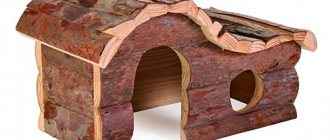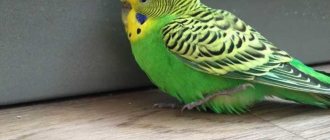Many cat lovers notice their pets’ strange craving for boxes and bags. As soon as an empty box appears in the house or a bag is empty of purchases, the cat is right there. Why do cats love boxes of all sizes, from small to huge?
Box - cat shelter
What attracts cats to them, why do they strive to fit into any of them? This question interests both scientists and cat fans, because the cats themselves do not want to answer, smiling mysteriously into their whiskers.
Cat hiding places in nature
For a person, a box is a capacious container and nothing more. For a cat, a box is a real refuge.
The box is a shelter for cats
All modern cats, both purebred and stray, have a wild forest cat in their ancestors. This is a fairly large fluffy animal, a dexterous hunter that attacks not only birds and rodents, but even roe deer, competing with lynx.
The wild forest cat is found in European and Caucasian deciduous forests. A wild cat has excellent hearing and vision, but its sense of smell is a little weaker, and it is impossible to be on guard 24 hours a day. Of course, she does not build houses for herself and does not dig holes, but she willingly takes refuge from bad weather and enemies under fallen trees, in hollows, abandoned fox and badger holes. Even a dense interweaving of branches, a rocky depression, a densely overgrown island in a floodplain, or a small hole will do. A wild cat is unlikely to sleep on an open lawn - it will climb higher on a tree or hide.
Cats feel calmer in a box
A wild cat waits out bad weather in its den; it may not go out hunting for up to three days. Female wild forest cats arrange a secluded place, preparing it for future kittens: they drag dry leaves, bird feathers and grass there. In such a cozy den, the kittens will be safe and the cat will be calm.
The benefits and harms of such entertainment
Anyone who has at least once tried to present a cardboard box to their cat will make such gifts again and again. And indeed, they have a lot of advantages for your pet:
Kittens get used to boxes from the very first days of their lives, which is why they help the animals calm down.
The cat bed problem is very easy to solve.
The cat is warm, cozy, calm and interesting in this life-saving box made of the most ordinary packaging cardboard. Even very small kittens in such a shelter perceive their new living conditions much more easily and get used to them faster.
There are few disadvantages, but they exist. Don’t chase beauty - a bright multi-colored box can be dangerous, especially for animals prone to allergies. Modern printing, unfortunately, often uses toxic inks - if a cat tastes such cardboard, it can get sick. Banal corrugated cardboard boxes are much safer, even if they are not very beautiful.
However, even with such harmless cardboard, a cat is quite capable of clogging its stomach - if, after playing too much, it chews off too much of it. Watch the animal and do not allow it to do this.
What is a box from a cat's point of view?
Scientists from around the world spend time and money on research trying to understand why cats love boxes and bags. Since cats themselves do not want to answer this question, scientists offer several versions - from quite reasonable to funny and incredible.
Only in a box do cats become themselves
Fantastic version
Cats are actually aliens from a distant planet. They monitor humanity, waiting until people reach the level at which they can be contacted. Hiding in boxes, they can relax - after all, it is difficult to constantly pretend to be a stupid animal. Only in a box, invisible to people, do cats become themselves.
Anti-stress version
Scientists conducted a study in which some cats were given boxes to use and could stay in them, while other cats were deprived of this joy. As a result, zoological experts were able to understand why cats love boxes: cats that had shelter had significantly lower stress levels than those animals that could not hide anywhere. The boxes helped the cats adapt to their new environment and reduced their stress levels, allowing them to be safe and feel a sense of security, just like in the wild.
The box helps reduce stress in cats
Anti-conflict version
It is worth watching a little of the cats that share their territory to understand: cats are animals that do not get into trouble and do not strive to intensify the conflict. They shouted and hissed at each other - and went their separate ways. Cat fights don't happen often. The reason lies in the fact that cats do not live in packs, in which they often have to sort things out, like it or not. Cats walk on their own, only occasionally meeting their own kind. Indoor cats are not trained to resolve conflicts, which is why cats love to sit in boxes. They long ago understood the truth: if you hide from a problem, it will disappear.
Temperature version
Experts from the National Research Council (USA) found out why cats love boxes.
Cats tend to crawl into cardboard boxes to keep warm
Attention! The most comfortable air temperature for domestic cats is 30-36º.
The thermal insulation properties of cardboard allow it to maintain this temperature, which is why cats tend to crawl into cardboard boxes to keep warm. If there is no box, you have to be content with lying in the sun or on the radiator.
Habit version
Some cat owners believe that the box is a familiar habitat for their pets. After all, the owners most often provide a box for a giving birth cat, and the kittens are familiar with this habitat from birth. Here the mother cat feeds them, licks them and raises them.
https://youtu.be/W2sxxAoPTKI
Olfactory version
Those who humanize a pet believe that a cardboard box, a box, or a stack of paper contains a woody smell that reminds animals of nature. This version is hard to believe because it doesn’t answer the question of why cats like to get into plastic bags that don’t smell like wood at all.
Game version
While feeding and petting a cat, people forget that even domestic cats are predators. And a predatory animal needs to hunt in order to feel good. By hiding in a box, box, bag, basket, and then suddenly jumping out of there, cats satisfy their need to hunt. This game is very popular not only with young cats, but also with adults, especially if the owner plays along, reacting to the pet’s actions.
Cats satisfy their need to hunt thanks to the box
Incredible version
After studying photographs of cats in drawers, boxes and other containers, British scientists suggested: cats are liquid! That's why they need reservoirs.
By choosing any guess why cats love boxes, and knowing how cats need all kinds of boxes, the owner will better understand his four-legged friend.
Finding a safe place
The way of life requires animals to find a safe shelter. Wild cats sleep most of the day. This is how predators save the energy needed for hunting. While resting, they need a safe place, protected from other animals. In nature, they climb trees, find holes, and hide in bushes.
At home, pets do not require such tricks. But instinct pushes us to search for shelter, explaining why cats love boxes and bags.
Even a small object seems like a suitable place for them to hide. A cat can settle into a box that only fits its paws and feel comfortable. The pet is calmed by the presence of limited space. Scientists have shown that access to boxes reduces stress in pets.
Shelter provides a feeling of security - the cat understands that it will not be attacked from behind or from the side. All potential threats must be brought into view.
An enclosed space becomes a cozy couch. But only if the cat got there voluntarily. Forcible attempts to place your pet in a carrier or bag will be met with aggression. But the cat can explore the same container on its own and choose it for sleeping or resting.
It is worth giving mousecatchers a choice of several hiding places. When bringing a cat home for the first time, it is advisable to release:
space under the bedside table (table);
a place in a closet with an easy-to-open door.
The animal will choose the offered shelter or find its own. So, the cat will hide in a constantly forming pile of clothes for ironing, a box under a folding chair (sofa). The presence of stationary shelters will not affect the interest in abandoned boxes (packages).
The curiosity that boxes and bags evoke
The packaging brings an abundance of smells. This is one of the reasons why cats lick bags. They also leave traces of the contents. Animals are attracted to the smell:
So, a cat will climb into a box of bleach, a product containing chlorine. Pets are attracted to new scents, especially those containing traces of other animals. The cat will show increased interest in a country box, a bag that has been in contact with the local fauna.
For pets, packaging becomes a source of information about the outside world. The contents, places of injury and production leave aromatic traces that can interest the pet. Having climbed into the box, the cat receives information about other places without leaving the room (yard).
Hunting or game
Entertainment is an additional reason why cats lick bags. In addition to food debris, the material attracts them by rustling and pliability on the claws. A cellophane bag becomes a favorite toy until it becomes unusable. Attracted by a scent or hiding space, the cat climbs into the bag.
The rustling light material is an interesting prey. The cellophane moves with a slight blow or push, prompting the animal to enter into a “fight.” Cats also see other packaging as a potential toy. How they are attracted to a surface for sharpening their claws:
- polystyrene foam, other foamed plastic;
soft woods.
The materials are used to produce containers where cats can hide: completely or “nominally”, climbing into a box without a lid or a box with large holes. From a hiding place, the pet can hunt others. Structures made of soft materials allow for additional improvement of the shelter. The pet tears off pieces of the structure, creating additional toys; makes holes, creates grooves, sharpening claws.
How to play using boxes
An attentive owner can take care of his pet. It's easy to make a simple toy that will still bring a lot of joy to your cat.
You can make holes in the box and put toys inside
- Take several boxes of different sizes and cut holes in them of such a diameter that the cat can freely crawl into them.
- Connect the boxes together horizontally and vertically using double-sided tape, leaving the passages clear so that the animal can get from box to box, from floor to floor.
- Give the cat the opportunity to roam around the boxes.
Advice! Two boxes placed on top of each other and connected by moves can fill your pet’s life with an interesting game: hiding and jumping out, “scaring” the owner.
A more complex option consists of plywood boxes, which are installed on supports covered with jute ropes. Such apartment buildings can be purchased at pet stores or built independently.
The box is a fun activity for cats
Scientific research
This question has interested even the scientific minds of our world for a very long time, and there are a huge number of versions on this subject. The famous Dutch veterinarian Claudia Vinck has been studying the behavior of cats in shelters for a long time. The decisive experiment in her work was the experiment with newly arrived animals that were still in a state of stress. Wink seated them in two different rooms, one of which was equipped with various hiding places, and the other remained free for prying eyes. As a result, animals with the opportunity to be left alone with themselves adapted to new living conditions much faster.
The result of the study was confirmation of the opinion that it is easier for cats to run away and hide from problems than to solve them, regardless of their size and habitat.
Cat safety in a box and bag
Cats love to play and sleep in boxes.
Advice! To prevent your pet from getting hurt, you need to throw out the silica gel packets from the box so that the cat does not eat them, mistaking them for prey.
You can make a cozy house for a cat out of a cardboard box.
It is not advisable for a cat to chew cardboard, although it is quite safe. True, most likely, the animal will not gnaw on a box that smells nothing.
Cellophane bags are much more dangerous: if an animal gets entangled in it, it risks suffocation. Therefore, games and running around with bags can only take place under the supervision of people. It is undesirable for cats to lick and chew bags - unlike cardboard, cellophane is dangerous for the stomach.
Matter of habit
A special opinion about why cats like boxes is the version that humans artificially instilled this habit in them. The thing is. that domestic cats most often give birth to their offspring in cardboard containers, and therefore, the smell of this material becomes familiar to kittens from birth.
It is from the very first days that animals associate the aroma of cardboard with warmth, comfort and security, and so that your pet loves to sit in your arms with the same intensity, you can try to accustom him to this from childhood.
Is the cat attracted to other objects?
The pet industry offers a huge range of different houses for cats. They look beautiful and original, they are not cheap, but they often delight the owners themselves more than their pets. The same goes for exquisite baskets, beds and other fashionable attributes that fit better into the interior than into a cat’s life.
Most cats themselves choose objects, sometimes quite unexpected for humans, which they then happily use as a house, a crib, a place to rest, ambush, meditate, or whatever. And there’s nothing you can do about it: every cat at heart is an artist, a creative person.
Photo gallery: “cat house” in the most unexpected place
A suitcase is no less interesting for a cat than a box Puss in Boots - this is what it really looks like Cats, like liquid, can fit anywhere A stump even better than a box reminds of ancient instincts A rustling bag is great entertainment for a cat Domestic cats can be found in the most inappropriate places
Video: where cats like to hide
How to wean an animal from playing with bags
If cats lick bags with enviable regularity, you can take the following steps::
- Carefully hide all cellophane packaging in places inaccessible to cats.
- If bags are used for the trash can, it should also be out of reach.
- If you suspect dental or oral disease, your cat should be taken to a veterinarian. The doctor will find out the cause of the disease, prescribe treatment, and the animal will stop showing interest in the unsafe toy.
- Buy your cat a special exercise machine with ropes, ladders and rest areas. Models of varying heights and complexity are available for sale to suit any budget. When the owners are not at home, the animal will not be bored, the cat will be able to occupy itself.
- Spend more time with your pet, petting it and playing with it. Always talk to a cat in a calm, even voice, even if the animal has harmed or damaged something.
- If a cat stole a bag somewhere and started playing with it, you should immediately take the dangerous toy away from him and offer him a ball or a fabric mouse in return.











